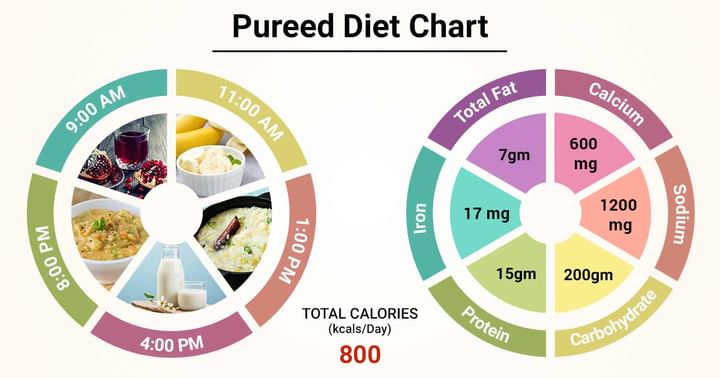Get the App
For Doctors
Login/Sign-up
About
Health Feed
Find Doctors
Diet Chart For pureed
Last Updated: Jan 20, 2025
About
A pureed diet is basically liquid solids or foods that require no biting or chewing and can be easily swallowed such as puddings or any other food item that can be blended to smooth texture like mashed potatoes, apple puree etc. Sometimes health issues or dental problems can lead you to consume pureed diets strictly. People who consume this pureed diet can tolerate a variety of consistencies; blended, chopped, ground foods are included as far as they can be easily broken without using a knife.
Most food that can be cooked and pureed can be included in this diet:
- As long as you have a good blender this diet is easy to make and follow. Hot cereals such as porridge or daliya, as they say, can form a part of a pureed diet.
- Vegetables like potato, carrots, sweet potatoes tomatoes can be blended to form a thick consistency for a pureed diet.
- To prepare a pureed diet, firstly peel out and remove the skin.
- Make sure there are no seeds in there, as they can change the taste after blended. Next is you need to cook it depending on the nature of the product; you can bake, boil or beat etc. Then you can blend it to give a smooth texture and consistency, always use liquids like water, milk, stalk to dilute it according to the ingredient used and its taste. And your puree is ready to drink or swallow within seconds! Curds, yoghurts, custards also can form part of pureed diets to treat your taste glands.
- Do avoid food like coconut, eggs, pasta, dried fruits or vegetables, nuts, seeds etc.
- These diets are best for toddlers as they are easy to prepare and make them eat as well.
- Even people suffering from illness who find it difficult to chew and break food can opt for this.
Diet Chart
| Sunday | |
| Breakfast (8:00-8:30AM) | 1 cup pomegranate juice + 1/2 cup oatmeal with honey and milk |
| Mid-Meal (11:00-11:30AM) | 1 cup banana and yogurt smoothie with honey and fine grated nuts |
| Lunch (2:00-2:30PM) | 1 cup moong dal khichdi + 1/2 cup curd |
| Evening (4:00-4:30PM) | 1 cup almond milk |
| Dinner (8:00-8:30PM) | 1 cup vegetable pureed soup |
| Monday | |
| Breakfast (8:00-8:30AM) | 1 cup apple juice + 1/2 cup samolina |
| Mid-Meal (11:00-11:30AM) | 1 cup strawberry and yogurt smoothie with honey and fine grated nuts |
| Lunch (2:00-2:30PM) | 1 cup boiled and mashed potato curry + 1 cup boiled and slightly mashed rice |
| Evening (4:00-4:30PM) | 1 cup almond milk |
| Dinner (8:00-8:30PM) | 1 cup tomato soup |
| Tuesday | |
| Breakfast (8:00-8:30AM) | 1 cup orange juice + 1/2 cup rice kheer |
| Mid-Meal (11:00-11:30AM) | 1 cup mango and yogurt smoothie with honey and fine grated nuts |
| Lunch (2:00-2:30PM) | 1 cup mashed and pureed rajma curry + 1/2 cup curd |
| Evening (4:00-4:30PM) | 1 cup almond milk |
| Dinner (8:00-8:30PM) | 1 cup chicken soup |
| Wednesday | |
| Breakfast (8:00-8:30AM) | 1 cup pomegranate juice + 1/2 cup broken wheat with milk |
| Mid-Meal (11:00-11:30AM) | 1 cup grapes and yogurt smoothie with honey and fine grated nuts |
| Lunch (2:00-2:30PM) | 1 cup masoor dal khichdi + 1/2 cup curd |
| Evening (4:00-4:30PM) | 1 cup almond milk |
| Dinner (8:00-8:30PM) | 1 cup pureed vegetables |
| Thursday | |
| Breakfast (8:00-8:30AM) | 1 cup apple juice + 1/2 cup rice kheer |
| Mid-Meal (11:00-11:30AM) | 1 cup kiwi and yogurt smoothie with honey and fine grated nuts |
| Lunch (2:00-2:30PM) | 1 cup custard with mashed banana |
| Evening (4:00-4:30PM) | 1 cup almond milk |
| Dinner (8:00-8:30PM) | 1 cup sweetcorn (mashed and strained) soup |
| Friday | |
| Breakfast (8:00-8:30AM) | 1 cup orange juice + 1/2 cup samolina kheer |
| Mid-Meal (11:00-11:30AM) | 1 cup strawberry and yogurt smoothie with honey and fine grated nuts |
| Lunch (2:00-2:30PM) | 1 cup mased chana dal + 1 cup boiled and slightly mashed rice |
| Evening (4:00-4:30PM) | 1 cup almond milk |
| Dinner (8:00-8:30PM) | 1 cup eggnog |
| Saturday | |
| Breakfast (8:00-8:30AM) | 1 cup pomegranate juice + 1/2 cup broken wheat with milk |
| Mid-Meal (11:00-11:30AM) | 1 cup mango and yogurt smoothie with honey and fine grated nuts |
| Lunch (2:00-2:30PM) | 1 cup boiled and mashed potato with yogurt |
| Evening (4:00-4:30PM) | 1 cup almond milk |
| Dinner (8:00-8:30PM) | 1 cup spinach soup |
Food Items To Limit
- Dry or tough meats : Hot dogs, Bacon, Sausage links, Beef tips, Peanut butter, Cubed cheese, cheese slices, Non-pureed fried, scrambled, or hard-cooked eggs, Nuts, Seeds.
- Starches, Breads & Cereals : Bread or bread products, Bagels, dinner rolls, Pizza, Rice, Granola, Cold cereal, Crispy, fried food, Popcorn, Crackers & Chips.
- Fruits : Raw, whole fruits, Dried fruits, Pineapple, oranges, or other stringy, high pulp fruit.
- Vegetables : Raw, whole vegetables, Salads
- Soups : Soups with chunks of meat or vegetables
- Deserts : Hard cookies, Hard candy, Chewing gum, Chewy candy or desserts
- Olives, Pickles
Do's And Dont's
- Consume a wide variety of foods to ensure your body gets essential nutrients.
- Eat small, frequent meals.
- Chew small bits- large bits may be difficult to swallow.
- Eat both hot and cold foods to provide a variety of temperatures in the diet.
- Sit the Patient in An upright, Erect Position: Sit the patient in a way that he/she is upright in an erect position. If unable to position themselves, you can prop them up with a few pillows.
- Patient Should be Positioned Head Tilted Forward/Chin Down: Assist the patient to tilt their head forward with their chin in a slightly forward position. It helps open the passage down to the oesophagus, unlike the head tilted back position which makes swallowing more difficult.
- Place food in the Stronger Side of the Mouth: If the patient has a facial weakness, be sure to place food onto the stronger side of the mouth. This is especially important as it will not only allow for maximum feeding, but also improve safety during feeding.
- Add more Support to the Impaired Side of the Patient’s Body: If one side of the patient’s body is weaker than the other, be sure to support the weaker side during feeding. This will make it much easier for the force of gravity to bring food bolus downward and pass through the impaired side with great ease.
- Position Yourself at or Below your Patient’s Eye Level: Sitting at or slightly below the patient’s eye level will make it easier for him/her for keep and maintain their head in the best feeding position and also allow them to feed much more comfortably.
Food Items You Can Easily Consume
- Thinned cooked cereals
- Pureed meats, fish, and poultry
- Pureed scrambled eggs and cheese
- Baby cereals
- Pureed ham, tuna, and chicken salad
- Pureed vegetables(avoid peas and corn)
- Mashed potatoes
- Pureed candled sweet potatoes
- Decaffeinated Coffee/Tea
- Ice cream
- Pureed fruits
- Thick milkshakes
- Plain yoghurt
- Cream
References
- Dahl WJ, Whiting SJ, Tyler RT. Protein content of puréed diets: implications for planning. Canadian Journal of Dietetic Practice and Research. 2007 May 17;68(2):99-102. [Cited 01 July 2019]. Available from:
- Cluskey MM. The use of pureed diets among the elderly. Dietetic currents (USA). Food and Agriculture Organisation of the United Nations, 1989 [Internet]. agris.fao.org. [Cited 01 July 2019]. Available from:
- Pureed Diet. UVA Nutrition. University of Virginia Health System, 2017 [Internet]. med.virginia.edu. [Cited 01 July 2019]. Available from:
Book appointment with:
Delhi
Mumbai
Chennai
Bangalore
Index
Table of content
Content Details
Written ByDrx Hina FirdousPhD (Pharmacology) Pursuing, M.Pharma (Pharmacology), B.Pharma - Certificate in Nutrition and Child CarePharmacology
Reviewed By
Find Dietitian/Nutritionist near me
Ask a free question
Get FREE multiple opinions from Doctors
posted anonymously



